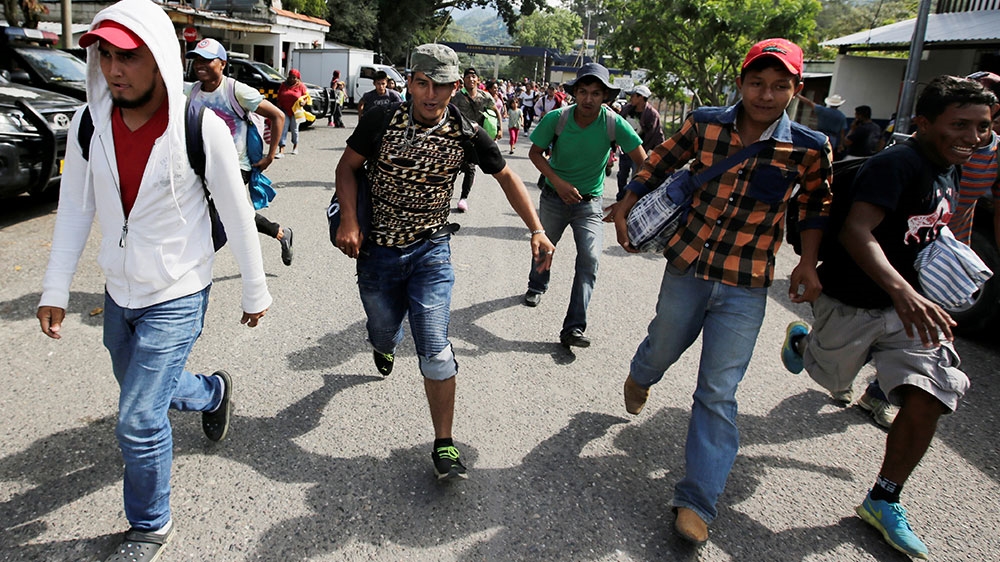
Esquipulas, Guatemala – Honduran activists blamed Donald Trump and the United States for the situation forcing thousands to flee the Honduras after the US president warned he may cut aid to the country if a migrant caravan isn’t stopped.
“The United States has strongly informed the President of Honduras that if the large Caravan of people heading to the U.S. is not stopped and brought back to Honduras, no more money or aid will be given to Honduras, effectively immediately!” Trump tweeted Tuesday morning.
The comment came more than three days after 1,000 people set out from San Pedro en route to the US. The caravan, which has now grown to more than 2,000 people, was blocked by Guatemalan police at the border on Monday, but was then permitted to enter Guatemala from Honduras.
Hondurans have the right to movement within the C4 region of Central America, including Guatemala, with basic identification. The Honduran government has no jurisdiction in Guatemala.
Honduran human rights activist Dunia Montoya, who accompanied the caravan to the Guatemalan border and whose husband, Bartolo Fuentes, was detained in Guatemala after crossing with the group, said Trump’s tweet “seems like a further abusive comment on the situation in the country”.
“[Trump] is responsible for the situation in Honduras. The Trump government validated an illegitimate government,” she told Al Jazeera.
Honduran president Juan Orlando Hernandez, currently in Colombia, has not made an official statement in response to the tweet.
But the Honduran Secretariat of Foreign Affairs issued a statement Tuesday afternoon, saying the government “urges Hondurans participating in this irregular movement to not let themselves be used by a movement that clearly seems to be political and that seeks to disturb the governability, stability and peace of our countries.”
Honduras’s unstable democracy
Honduran democracy has been unstable over the past decade. In 2009, elected president Manuel Zelaya was ousted and illegally expatriated by the military, though civilian rule continued.
President Hernandez took office in 2014 following a stint as president of congress. His National Party had consolidated majority control of all three branches of government.
Despite the constitutional prohibition on reelection and its use as a justification for the 2009 coup, Hernandez sought reelection following a contentious and irregular Supreme Court ruling essentially declaring part of the constitution to be unconstitutional.
 |
| Honduran migrants, part of a caravan trying to reach the US, run after crossing the border between Honduras and Guatemala [Jorge Cabrera/Reuters] |
Zelaya’s LIBRE party that grew out of popular resistance to the 2009 coup formed an opposition alliance and its candidate Salvador Nasralla was winning the presidency, according to the initial results of general elections held last November. But then Hernandez suddenly surged into the lead amid widespread reports of fraud and irregularities.
Weeks of protests and blockades ensued, and more than two dozen opposition protesters were shot and killed by state security forces, according to Honduran and international human rights organisations.
Hernandez was declared the winner in mid-December, and US recognition of his victory consolidated what was widely viewed as election fraud.
“What is happening in Honduras is the accumulation of the consequences of legitimising a fraudulent government. They provoked this mass migration from Honduras,” said Montoya.
“Now they threaten not to give money to Honduras, but the truth is that does not alarm the people who are fleeing because that aid never makes it way into their hands,” she said.
US pressures Guatemala
On her husband’s arrest in Guatemala, Montoya was unable to confirm the details at the time of publication. Fuentes is a former LIBRE party congressman and a longtime social movement and migrant rights activist. Nineteen years ago, he helped found an association in his hometown of El Progreso, in northwestern Honduras, for relatives of immigrants who had disappeared along their journeys to the US.
Guatemalan President Jimmy Morales is also facing open pressure from the Trump administration to halt the caravan and turn it around.
US Vice President Mike Pence called Morales Tuesday and urged him to “cooperate” with the US to curb immigration.
 |
| Honduran migrants, part of a caravan trying to reach the US, gesture while arriving to the border between Honduras and Guatemala [Jorge Cabrera/Reuters] |
Jorge Santos, the executive director of UDEFEGUA, a Guatemalan non-governmental human rights organisation, accused the Guatemalan government of taking action against the migrant caravan to serve US interests.
“Neither the Guatemalan police nor the army should intervene,” said Santos.
Guatemala’s interior ministry was not immediately available for comment.
‘Let’s go’
Largely on foot at this point, the caravan continues its journey towards the US, though it will likely be days before participants reach Guatemala City. The group left Esquipulas Tuesday morning to try to head another 50km up the road to Chiquimula.
The Honduran national anthem rang out in the plaza outside the Cathedral Basilica, as the last hundreds of migrant caravan participants prepared to leave the city.
The Basilica in Esquipulas is home to a revered wooden “Black Christ” image and is a site of religious pilgrimmages and excursions from around Guatemala and beyond. Tuesday morning it was the site of a different kind of pilgrimmage.
As they prepared to leave Esquipulas on foot, Honduran migrant caravan participants followed up the national anthem with cries of, “Let’s Go!” and the occasional “Fuera JOH!,” in reference to Honduran president Juan Orlando Hernandez.
Hundreds more are attempting to catch up and join the caravan, and many set out from Honduras for Guatemala Tuesday. According to local news reports and footage Tuesday afternoon, Honduran security forces blocked their exit from the country.












